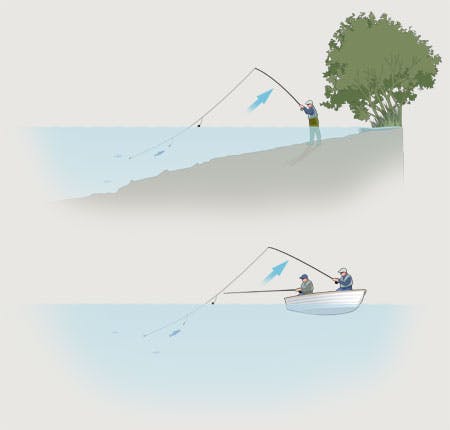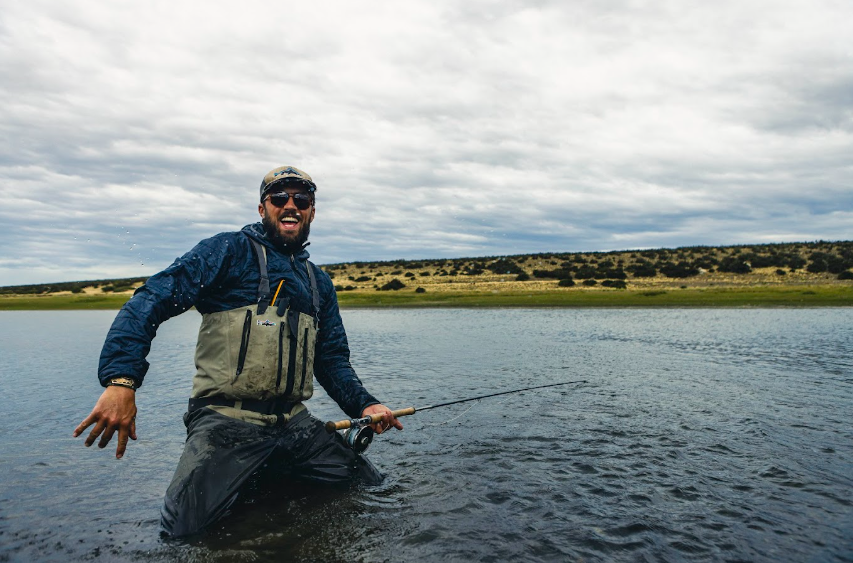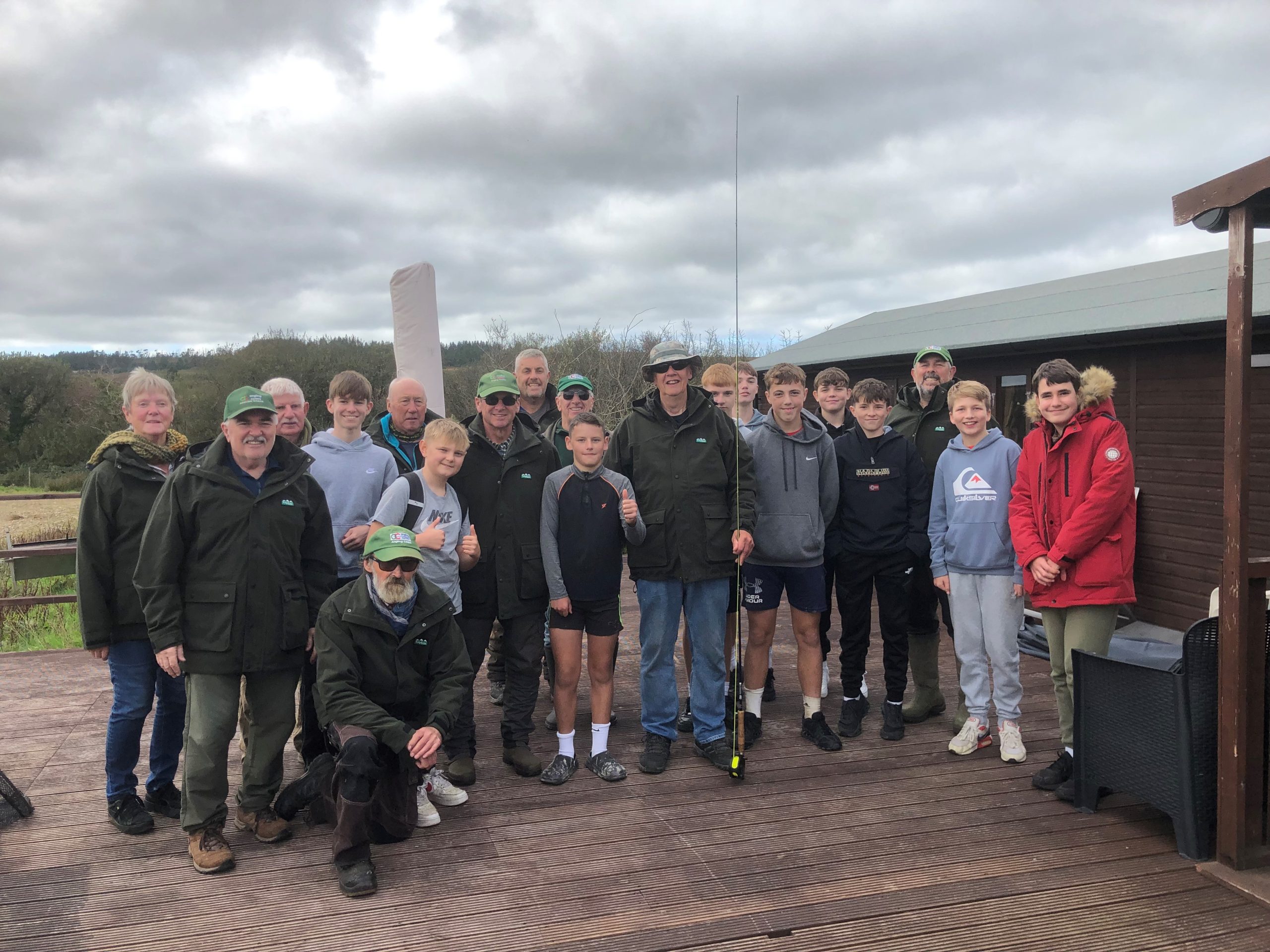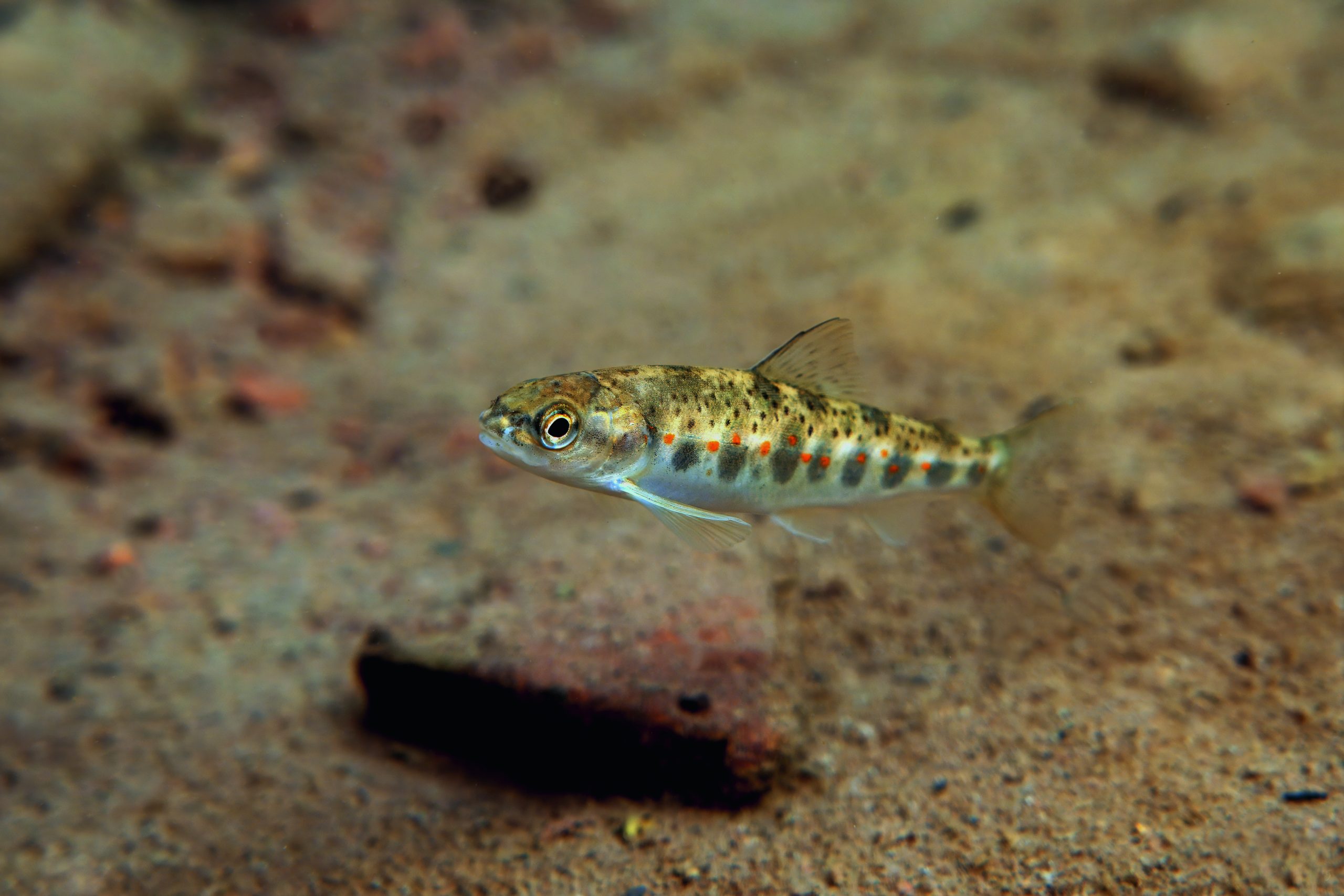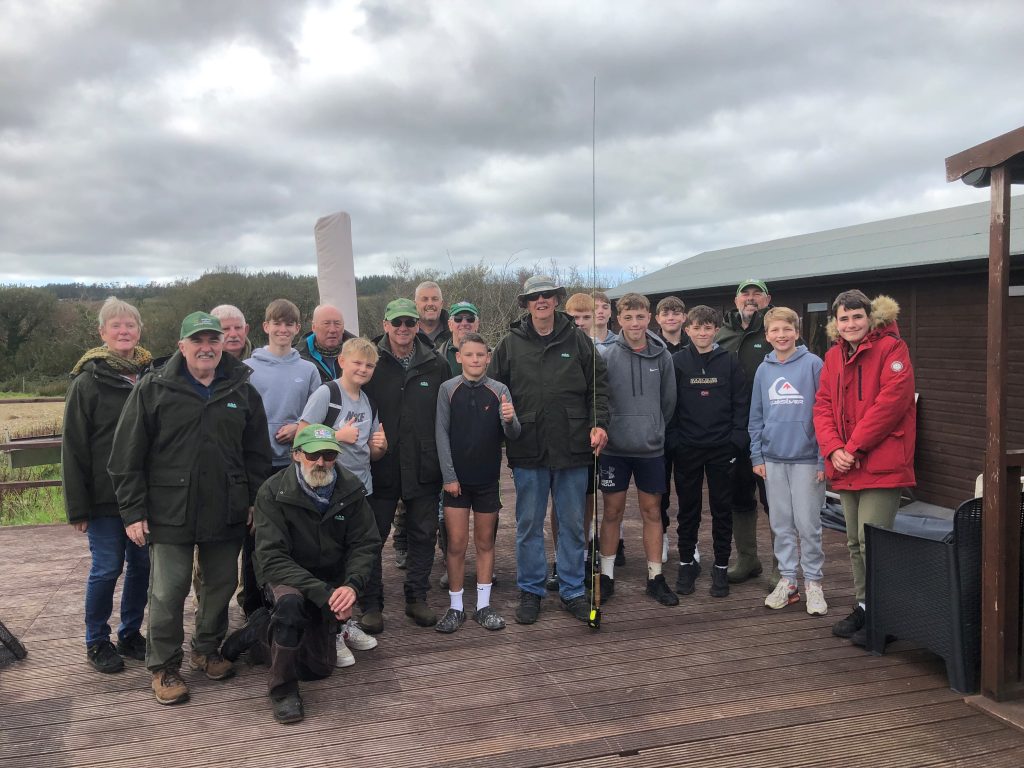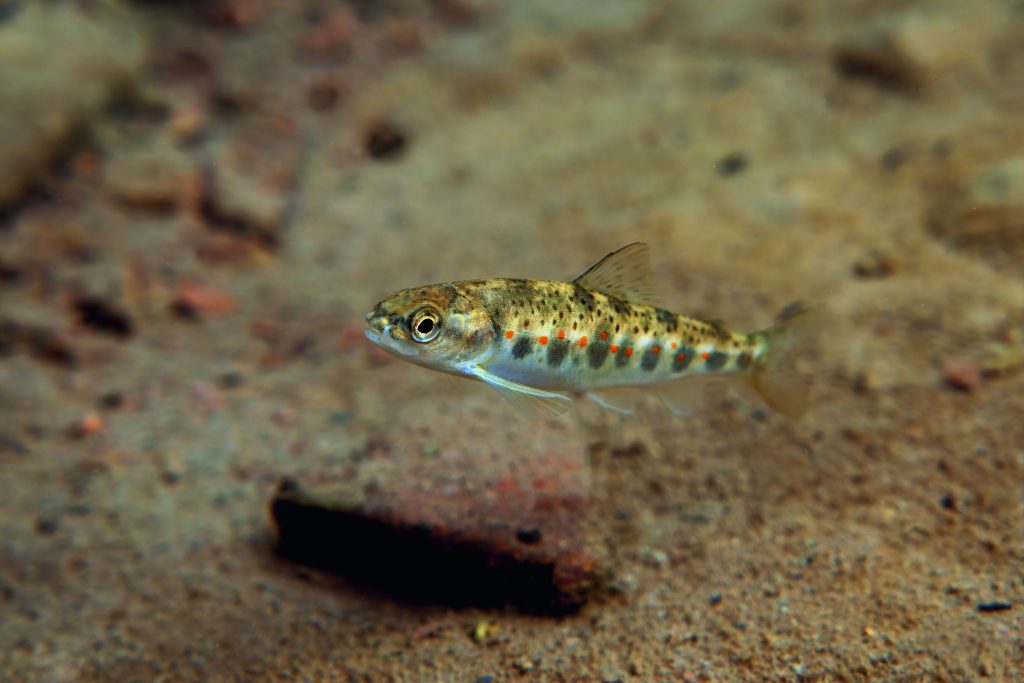THE ESSENTIAL GUIDE TO OLIVES
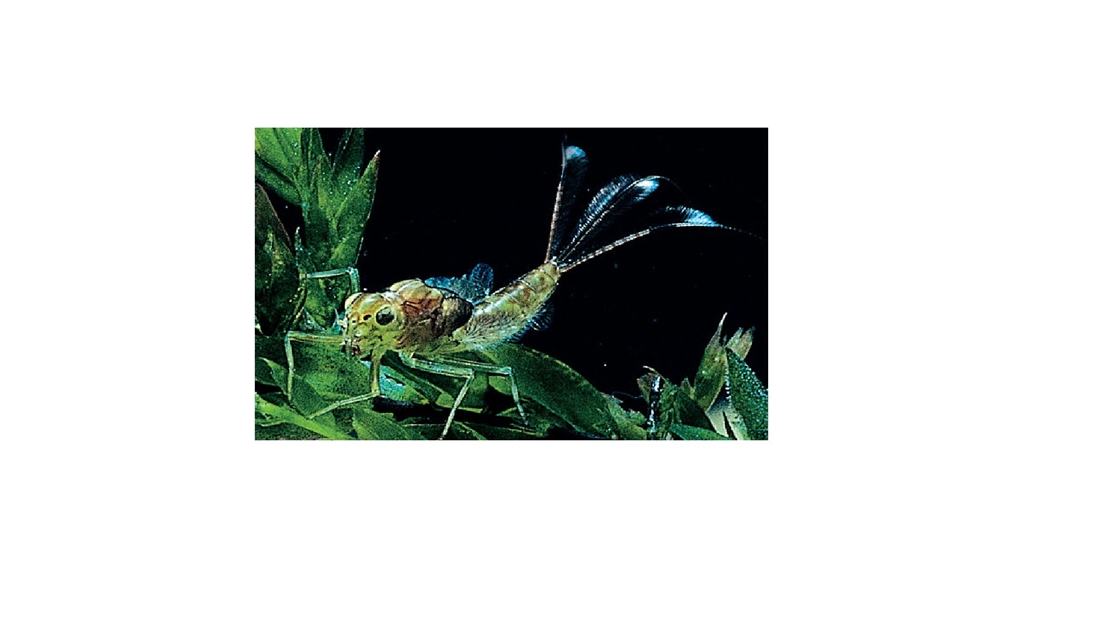
As many insect species become available now, May is rightly considered “the month” for fishing. There are mayflies, some early sedges, olives, caenis and not to mention terrestrials. I could wax lyrical about the much celebrated mayfly hatch that occurs, but there are a couple of more widespread upwinged flies which, due to their prolonged hatch season, are of significant importance to us stillwater flyfishers.
Collectively known as “olives” the Lake Olive Cloeon simile and Pond Olive Cloeon dipertum, peak in May when we can expect top drawer dry fly and nymph fishing.
According to reference the Pond Olive Cloeon dipertum is more likely to be found in ponds, tarns and shallow areas of larger waters. As you’d expect, the Lake Olive Cloeon simile is more at home on larger lakes and reservoirs where it is said to prefer deeper water. As both species are similar in appearance and habits it seems sensible to encompass them both under the “olive” heading.
IDENTIFICATION
Mostly olive brown in colour mature olive nymphs are 10-12mm long and slender. Geographic location and habitat might have a bearing here. Both species of nymph have three heavily fringed tails, which contributes to their impressive turn of speed. And because of their swimming prowess they are commonly known as agile darters. Though following a short burst the nymphs need to rest.
Studying nymphs in an aquarium, during the resting period they splay out their legs and tails. Is this to create a greater surface area, in a bid to stop them sinking too far on an upward journey? Whatever the reason, keep in mind these swift bursts and pauses when imitating such nymphs.
THE WET WEATHER FLY
Olives are seen as a “foul weather fly” with wet, windy conditions seeing the densest hatches. Wave action, creating a weaker surface film, and windy conditions help the newly hatched adults (duns) take flight sooner. But, in more wet, colder weather the duns may stay on the water’s surface longer, providing easy pickings for trout.
SIGNS OF A HATCH
Faced with normal conditions nymphs will begin to ascend and emerge from late morning. During initial hatches, trout can seem slow off the mark. Thankfully, olives are often quite reliant and several consecutive days of activity will see a routine develop. Once olives are on the menu, it can be worth fishing nymphs at anytime as trout fully expect to see them. If you’re on a large sheet of water, look for signs that might point to any activity. Martins, swallows and even gulls hawking over the water are sure indicators that something’s happening. Even on smaller reservoirs, always keep an eye open for birds working a given area.
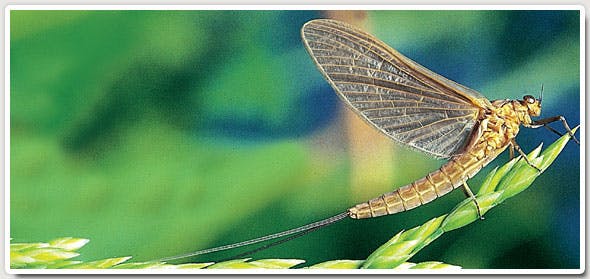
HOW TO FISH
Crosswinds impart a more natural drift to the flies. I’ll start with two nymphs positioned some 5ft apart on a 14ft leader. Having cast out, allow the flies time to settle then using the figure-of-eight retrieve, give a little burst to the flies, followed by a longish pause to mimic the nymph’s progress and resting mode. Remain focussed at all times and respond to the slightest movement/hesitation of the fly line. Naturally, the line tightens if the flies are intercepted when in motion. But takes often come during the pause or when the retrieve recommences, so pay special attention at such times. As three flies plummet further than two, if no takes are forthcoming and there’s little surface activity, then a third fly might be included.
This is a great way to search the water in front of you.
CHANGE TO A DRY
Once the hatch starts, consider changing to a dry fly. But, I’ve known occasions when, despite duns littering the surface, trout have ignored them in preference of nymphs. In fact, it’s not unusual to fish right through the hatch using only nymphs. Granted, they might have been presented on a partially greased leader but never underestimate their effectiveness. However, as dry fly fishing is the very pinnacle of our sport, I’m always eager to change and it frequently works out for the best.
I act on what my eyes see, it only takes one or two rises for me to switch over. But, if 30 minutes elapse without action, either move or, if you encountered fish on nymphs beforehand, try them again.
STUDY THE RISE FORMS
With an increasing number of rising trout, it’s worth stopping to study the rise form. Trout bulging beneath the surface, or a flattening of the wave, mean fish intercepting nymphs just subsurface. At such times, try two lightweight nymphs presented on a shorter leader (approx 9-11ft) made of copolymer.
If this fails then try attaching an emerger/dry pattern to the point or even top dropper, this will help hold the nymphs in the upper layers. When the back of a trout shows, followed by a wave of the tail, it’s odds on they’re nailing emergers.
Offer two emerger patterns or Spiders spaced 5-6ft apart. Clearly visible, there’s no mistake when trout pick duns off the surface. Usually the unfortunate fly is engulfed by a dark “neb” protruding through the film. In a healthy wave this might not be so obvious and because the duns get airborne sooner now, trout need to move quicker, walloping duns with a splashy rise. Such times make it difficult to decipher whether trout are targeting emergers or duns. Giving the best of both worlds, I fish one of each. The dry is placed on the dropper with an emerger on the point. Often the emerger becomes swamped and sink. But the fly is still fishing for you. Remember, many naturals don’t make it and, spent-like, get washed along subsurface. Takes to partially drowned emergers register as either a confident draw or the dry fly skating sideways and even disappearing completely.
SEASONAL HATCHES
Olives begin to appear from May, with heightened activity into early June. They remain throughout summer when sparser hatches usually consist of smaller, lighter coloured naturals. Autumn then sees olives having one last fling before winter. Although we look to spring for the cream of our sport, the back end hatches are significant and end the season on a high note.
Don’t discount Spider patterns, a team left to flutter in a rolling wave can be deadly. My preference is two scantily clad Spiders positioned below a palmered bob fly. In fact, such is the versatility of Spider patterns they can be used with wets, dries, nymphs and emergers. So, be sure to have a few Greenwell Spiders and Waterhen Bloas.
COLD WIND/MINI HEATWAVE
If spring throws a cruel Arctic blast then olive hatches can suffer. Then wait until lunchtime before venturing out. At times, it’s been 2pm before the first dun showed.
These hatches are sparse and short lived, so act fast. Conversely, a mini heatwave dominating late May and early June can suppress hatches to unsociable hours. If you arrive at the water for a midday hatch that doesn’t materialise, revise your game plan. I got on to this by pure chance. May 27th, fully expecting buzzer to be present, I arrived at the reservoir just after 6am. A high pressure system made it possible for short sleeve attire.
Walking to a known hotspot, a single newly-emerged dun rested in the margins. Obviously with its wings in that typical upright position and still possessing stunted, not yet fully formed tails. Within minutes, more duns appeared on the surface and then came the trout. Humping rises at first, signalling that nymphs were their prey. Still calm, those nymphs struggled to pierce the heavy surface film. In undisturbed water, nymphs easily become trapped beneath the film where, tired and weak, they are fed on by trout.
A nymph fished 5ft behind an emerger, provided a good hour’s sport. By 8am it was all over. Since then I’ve witnessed many hatches at first light during hot weather. Equally, don’t rule out an early evening hatch.
HAVING EMERGED…
Safely emerged, the duns (sub imago) head for bankside shelter, to change into the sexually mature spinner stage (imago). Dependant on conditions this usually takes place within 36 hours. As spinners begin to accumulate from earlier hatches mating soon takes place.
Then, female olive spinners return to lay their eggs at the surface. In the case of the Pond Olive Cloeon dipertum, the eggs uniquely hatch inside the female, and tiny larvae are released at the surface.
OLIVE LIFECYCLE
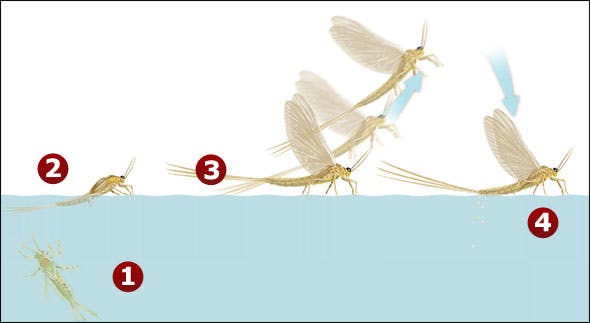
1 Nymph swims towards the surface
2 Then emerges through the surface film
3 Newly emerged adults begin flight
4 Females return to lay eggs at the surface
NYMPH Developing in weedy parts, olive nymphs make several moults through winter before maturing and swimming to the surface to emerge.
DUN (SUB IMAGO) This is the juvenile winged adult stage. Dusky opaque in appearance it’s not yet ready for mating.
SPINNER (IMAGO) Now sexually mature they seek a mate. They have clear wings, longer tails and more brilliant livery. After mating they perish, lying spent on the water’s surface.
EVENING SPINNER SPORT
Early evening spinner falls often continue into darkness and if calm conditions persist until dawn there might be enough spent spinners to promote a dawn rise. A little hit and miss at best, spinner falls are difficult to predict. Unlike the dun where you might see significant numbers on consecutive days, spinners cen be present one evening and absent the next. Weather conditions will have the final say.
Those warmer, still evenings hold a chance of finding trout confidently slurping down spinners.
SINGLE FLY TIME
This is single fly territory and it can be worth stepping down a line size for improved presentation. Rather than randomly covering the water, go in search of rising trout. The spinners may have chosen a quiet corner or sheltered bay to deposit their eggs, so activity can be extremely localised. Use a tapered leader of 12-14ft with a sparsely dressed spinner pattern. Lightly smear grease along the leader, in case the spinner slips sub-surface.
During flat calms this treatment not only helps suspend the swamped fly but acts as a sort of refined indicator. Trout taking spent spinners know that their meal isn’t about to flutter off, giving them a more languid feeding manner. I’m happy with a greased leader, so long as the line remains still – as it should be when fishing spinner patterns.
LOCH-STYLE IN A BREEZE
Given any appreciable breeze, traditional loch-style methods from either bank or boat really do take some beating. It’s worth using the stiffer characteristics of standard monofilament here that helps in maintaining tangle-free droppers.
As to dropper knots, a 2-3 turn water knot is as reliable as any. These days, I find that a 2-turn knot useful. The top dropper/bob fly benefits from being heavily hackled to create disturbance. Favourites include the bumble family and palmered dabblers.
RETRIEVES & THE HANG
During really blustery conditions, use three such patterns though I’m happiest with a slim Dabbler on the middle dropper with a nymph bringing up the rear. As to retrieval rates, mix these up until you find what the trout want. Sometimes flies quietly tripped through a wave work best and, on other occasions, it’s a fastish retrieve that gets a response. Don’t forget to hang them at the end of each retrieve. A surprising number of trout succumb to flies that are left loitering here for a few moments. Although this is a known tactic from the boat, it can produce just as well from the bank and should become second nature when fishing wets.
HANGING WETS BOAT AND BANK
With a heavily palmered bushy dry fly on the top dropper, lift the rod at the end of the retrieve and “dibble” the pattern on the surface to create an attractive wake. Fish will either nail this fly r the wets close behind. Many following trout are caught by hanging the flies.
